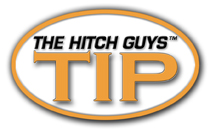Hitches and Towing 101
|
CHAPTER CONTENTS | |
| 1. Introduction to Towing | 7. Brake Controls |
| 2. Towing Components | 8. Hitch Installation |
| 3. Types of Hitches | 9. Hooking Up |
| 4. Determining Tow Capacity | 10. Tow Bars/Dinghy Towing |
| 5. Selecting Your Hitch | 11. Towing Safety |
| 6. Wiring/Electrical | 12. Preparing Your Tow Vehicle |
Chapter 6 -
Wiring/Electrical
Before
you can legally tow your trailer on public roads, you have to have working
trailer lights. In fact, this is more important than simply risking a ticket -
if your trailer lights don't work, you're inviting an accident. Always check
your trailer lights before you leave on any towing trip, no matter how short.
Most trailers come with lights and wiring installed for you. If your
trailer's lights and wiring are missing or beyond repair, it's usually very easy
to install replacements. Any reputable camping or trailer center will have kits
that use standard wiring connections and standard color-coded wires.
Understanding Trailer Wiring
Trailer wiring harnesses use 4 to 7 wires to
control basic lighting and brake functions. The simplest connectors for the
smallest trailers use four wires on a flat plug to control tail lights, brake
lights, and turn signals. Connectors with 5, 6, and 7 wires add (in order)
backup lights, electric brake control, and auxiliary power. To make trailer
wiring less confusing, there's a standard color-coding for each of the 7
possible wires and their functions. The chart in Figure 6-1 shows standard wire
colors and their functions:
|
4-Way |
5-Way |
6-Way |
7-Way | |||
|
Green |
Yellow |
Brown |
White |
Red |
Blue |
Purple |
|
Right Turn & Brake |
Left Turn & Brake |
Tail Lights |
Ground |
Backup Lights |
Electric Brakes |
Auxiliary Power |
Figure 6-1: Trailer Wiring Color
Codes
If you stick to the format shown in Figure 6-1, your trailer will be
compatible with most tow vehicles and wiring kits. If your trailer needs wiring,
your best solution is to purchase a light kit that includes wires. You might
need to drill holes or even have some tabs welded to your trailer to mount the
light kit, but unless you are very confident in your wiring skills, a kit is
always your best bet.
Choosing a
Connector
Assuming that your trailer wiring is
in order, you also have to connect that trailer wiring to your tow vehicle. Most
trucks, vans, SUVs and RVs made since the mid-1990s include factory-installed
trailer lighting connectors and even ready-made plugs in the cabin to connect a
trailer brake controller. If your vehicle is so equipped, setting up your
trailer electronics will be easy. However, if your vehicle is not prepared for
towing, you will need to install a wiring connector. With some planning and
research, you can safely splice trailer wiring connectors into your vehicle's
wiring system, or take your vehicle to a professional camping or trailer shop
and have the wiring installed there.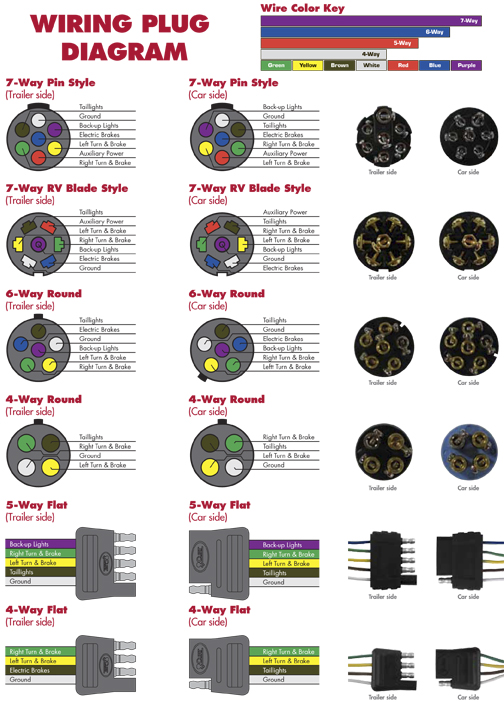
Figure
6-2: Trailer Wiring Connector Styles (click above image to enlarge)
Most lighting kits use the common
4-way flat connector with 3 male and 1 female end. The connector is designed
this way so that you cannot connect the plug backwards. This connector is
mirrored on the vehicle side. Be sure to connect the white wire from the plug to
a good ground on your trailer chassis. Then you can connect the ground wires
from each light to the chassis for a solid ground path.
If your trailer
includes backup lights, you can still use a standard wiring kit, but most
vehicles that are wired for towing do not include a 5-way flat connection. You
may need an adapter, or to install extra wiring in your vehicle to support the
extra light. 5-way flat and 4-way, 6-way, and 7-way round pin connectors are
comparatively rare compared to the 4-way flat and 7-way RV blade style
connectors.
If you have a truck, RV or SUV made since the mid-1990s,
chances are it was made with a 4-way flat connector, a 7-way RV blade style
connector, or possibly both. In general, if your trailer uses electric brakes,
you should install the 7-way RV blade connection whether or not you plan to use
backup lights or auxiliary power. If your trailer does not use electric brakes,
chances are you'll be fine with the 4-way flat connection.
If you do need
to connect all 7 wires, the best solution is to use a sealed weatherproof wiring
box, available at any camping or trailer center, and bring your lighting wires,
your brake wires, and your auxiliary wires (if any) together in the box. Then
run a harness to your connector from the box. The box may be located anywhere on
the trailer, but place it so that it's safe from road hazards and from weather.
As with any wiring, make sure your connections are solid and your wires are
protected.
If you doubt your ability to do a good job on trailer wiring,
take your trailer to a professional. A rewiring job doesn't take long or cost
that much.
Locating Factory-Provided Hookups on Your
Vehicle
If your vehicle came from the factory
with a towing or camping package, chances are that the factory also installed a
4-way flat or 7-way RV blade style car-side connector. The 7-way connectors are
always in the vicinity of the center of your rear bumper, mounted on a tab or
mounted into the bumper itself. Sometimes, 4-way flat connectors are tucked up
under the rear of the vehicle. Your vehicle owner's manual should tell you how
to determine if a connector is already installed. Figures 6-3, 6-4, and 6-5 show
you representative examples of these parts.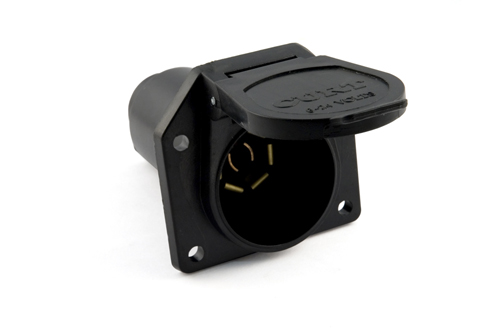
Figure
6-3: 7-way vehicle-side
connector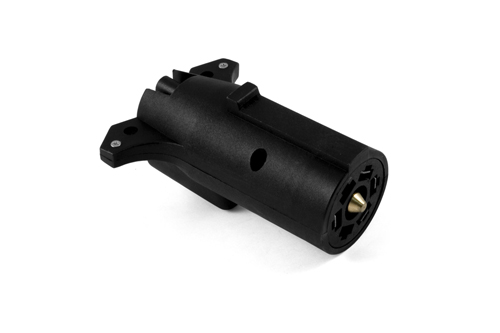
Figure
6-4: 7-way RV blade style trailer-side
connector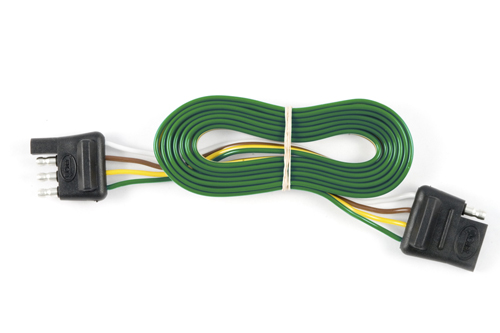
Figure
6-5: 4-way flat wiring with both connectors
If your
vehicle does not have a connector installed, it may have wiring plugs in place
to help you install trailer wiring. Figure 6-3 shows common locations for wiring
plugs in different types of vehicles. You should talk to your dealer, read your
owner's manual, and check your vehicle thoroughly before you cut or tap into any
wires on your vehicle.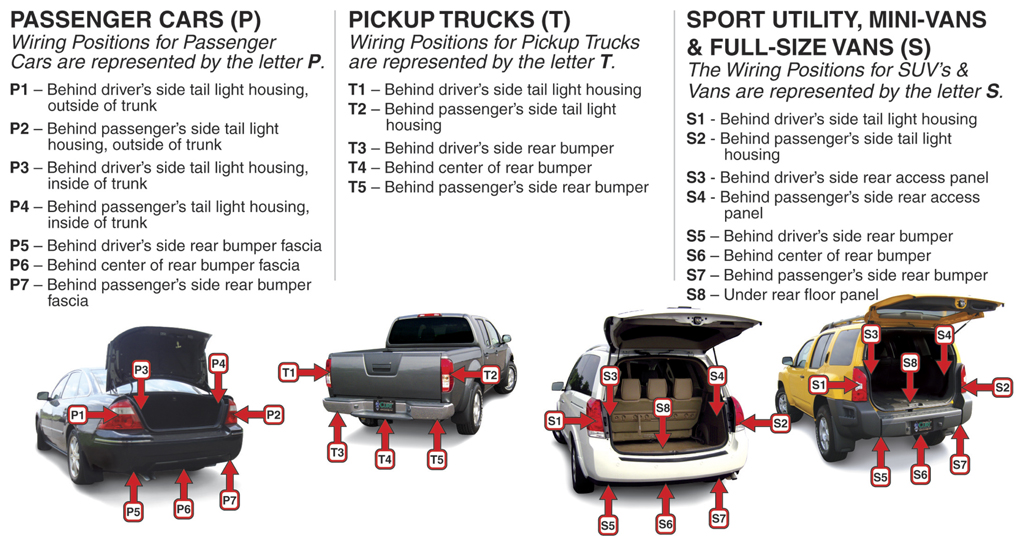
(click image to enlarge)
Figure 6-6: Trailer Wiring Hookup Locations
Make sure you are absolutely certain that no
provisions have been made for you before you think about tapping into your
wiring. Even the best taps weaken your wires and cut through the
factory-provided wire sheath. If you can avoid taps, you're better
off.
Installing Trailer Wiring Connections
If you
have an older vehicle or one that was not designed for easy towing, you may need
to tap into your existing vehicle wiring harness to install a towing connector.
Luckily, most of the wiring you need connects to your vehicle's tail lights. The
exception is the wiring for a brake controller, but if your vehicle was not made
with a towing package, you should take special care before attempting to tow a
trailer large enough to require brakes and a controller.
You might need
to remove your vehicle's tail lights to access the wires you need, and those
wires may not correspond to the trailer wiring color scheme shown above. The
best practice is to obtain a schematic drawing of your vehicle's wiring, but you
can also determine the wiring plan for yourself by turning on each light (tail
light, right turn signal, left turn signal, brakes) in turn and using a
voltmeter to note which wires receive current.
|
|
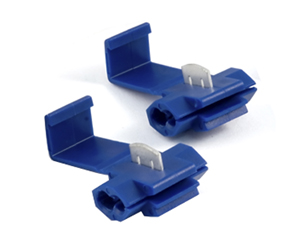
Figure
6-7: Wiring Taps
When you have
labeled your wires, you can use taps like the ones shown in Figure 6-7 to add an
additional wire to any circuit. Place your trailer connector wire in the tap,
and then position the tap around your vehicle's corresponding wire. Use a pair
of pliers to fold over the clamp and the metal blade slides over the existing
and the new wire. The blade cuts the plastic insulating sheath around the wires
and makes a new connection. The clamp snaps into place and holds the tap on the
wire. Run your new wire to your vehicle-side connector.
As you install
the taps, remember that the brake lights on your trailer are a combination of
both the right and left turn signal lights. You need to tap into just three
wires to install a 4-way flat connector: right and left turn signals, and one
tail light wire. Connect your ground wire on the vehicle side to a good ground
on the vehicle's body or chassis.
|
|
If you need to install a brake controller, see Chapter 7 for
information on those products.





